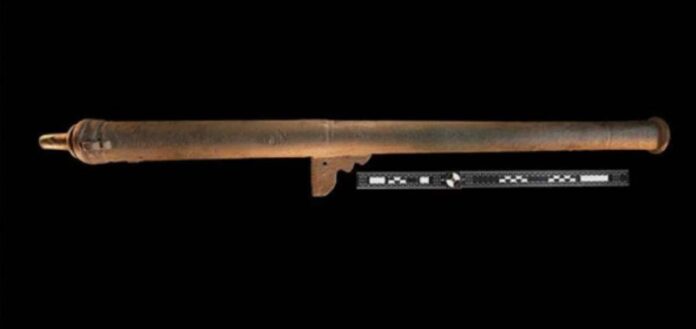A groundbreaking discovery in southern Arizona has uncovered the oldest known firearm in the continental United States. A bronze wall gun, dating to the Coronado expedition of 1539–1542, was excavated in the Santa Cruz Valley at a site discovered several years ago. This rare find sheds light on the weaponry and interactions between Spanish explorers and Native American communities during the early years of European colonization in the American Southwest.
The firearm, identified as a medieval-style cannon, measures 42 inches (106.7 cm) in length, weighs approximately 40 pounds (18 kg), and has a bore diameter of .95 inches (24.7 mm), equivalent to a 5-gauge shotgun. Likely used to breach fortifications, this piece is emblematic of the expedition’s militarized approach to exploration and is described in a study published in the International Journal of Historical Archaeology.
Coronado’s Quest for Wealth and Conquest
Francisco Vázquez de Coronado’s expedition, organized by Viceroy Antonio de Mendoza, set out to find the fabled Seven Cities of Cíbola, as explained in a Phys.org report. Inspired by tales of unimaginable wealth recounted by Fray Marcos de Niza, Coronado invested heavily, mortgaging his wife’s property to fund the venture. The expedition included 150 cavalry soldiers, 200 infantrymen, and numerous Native allies, traveling north from Mexico into the Southwest in search of riches.
Coronado’s journey proved to be a costly disappointment. The cities described by de Niza were modest Pueblo communities rather than the golden metropolises he had imagined. The expedition resorted to looting and violence, taking blankets and pottery from Indigenous settlements before retreating after reaching the Great Plains of Kansas.
The cannon, mentioned in the study “Coronado’s Cannon: A 1539–42 Coronado Expedition Cannon Discovered in Arizona,” provides a tangible link to this historic yet controversial campaign.
The wall gun was resting on the floor of a Spanish structure. This figure shows it while under excavation, held firmly in place by roots. (International Journal of Historical Archaeology)
Unearthing the Cannon
Discovered at the site of a Spanish stone-and-adobe structure, the cannon was partially buried and entangled in roots when unearthed. Researchers employed radiocarbon dating and optically stimulated luminescence to confirm the structure’s age, which coincides with Coronado’s presence in the region.
Other artifacts found at the site—including fragments of European pottery, olive jars, glass shards, and weapon components—further support the link to Coronado’s expedition.
The cannon itself, known as a wall gun, was an early firearm operated by two people. Originally designed for defensive purposes along fortifications, it was repurposed by Coronado’s forces for offensive actions against light fortifications such as wooden or adobe walls.
The cannon’s design offers additional clues about its origin. Its plain sand-cast structure, marked by three sprue lines and four iron pins, indicates it may have been manufactured locally in Mexico or the Caribbean rather than Spain, where decorative casting techniques were more common. This raises the possibility that it had been purchased secondhand, potentially from an earlier Spanish expedition like that of Ponce de León.
The Aftermath and Abandonment
Historical records suggest that the cannon was left behind during a Sobaipuri O’odham attack on the Spanish settlement, notes the study. Clusters of lead shot and Sobaipuri arrowheads found nearby corroborate accounts of a confrontation. The cannon, found unloaded and showing no signs of battle use, prompts questions about its abandonment.
Was it too heavy to transport during a hasty retreat, or was it left deliberately as the Spaniards prioritized survival? These unanswered questions highlight the challenges faced by Coronado’s expedition, which struggled with logistical difficulties and hostile encounters throughout its journey.
Significance of the Find
This discovery marks the first firearm directly tied to the Coronado expedition and provides new insights into the era’s military technology. It also underscores the complex and often violent interactions between European explorers and Native American communities.
Further analyses of the cannon and associated artifacts aim to uncover more about its origins and use. Researchers hope this find will offer a deeper understanding of early Spanish expeditions in the Southwest and the impacts of colonization on Indigenous peoples.
Top image: The excavated and restored bronze medieval-style wall or rampart gun found the Coronado expedition site in southern Arizona. Source: International Journal of Historical Archaeology
By Gary Manners




